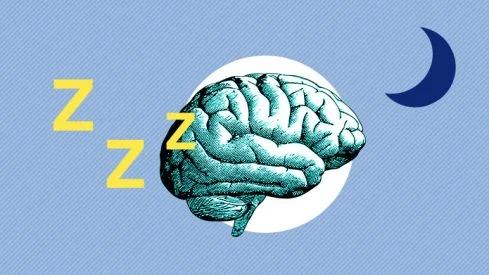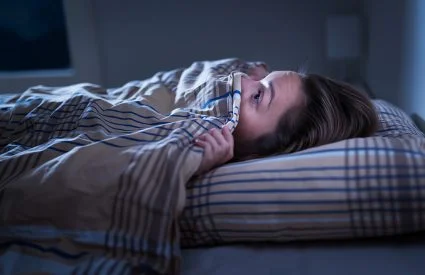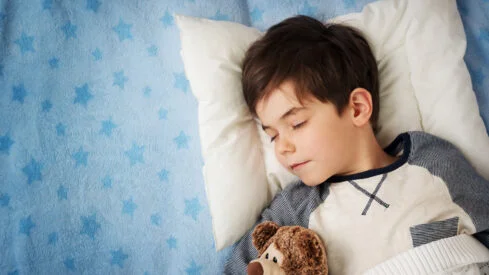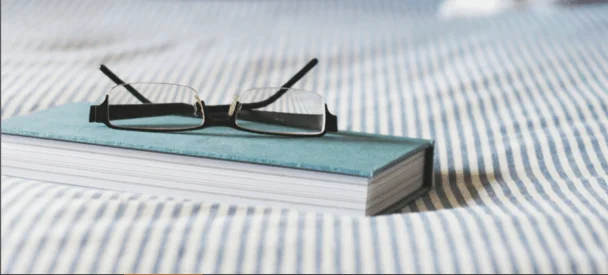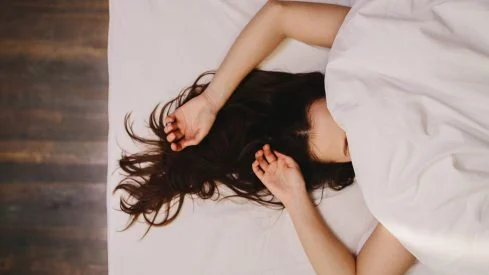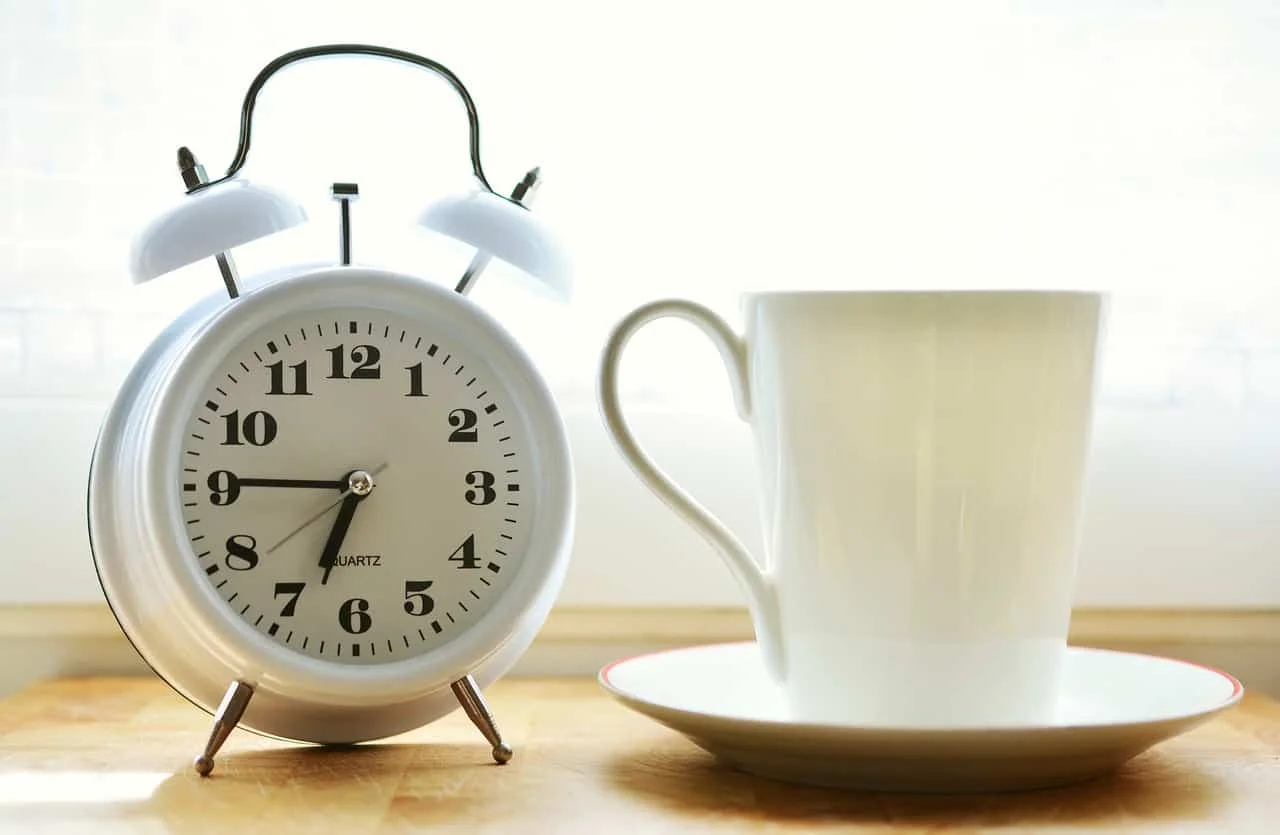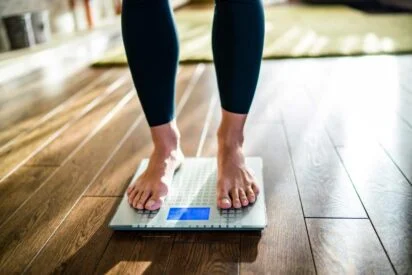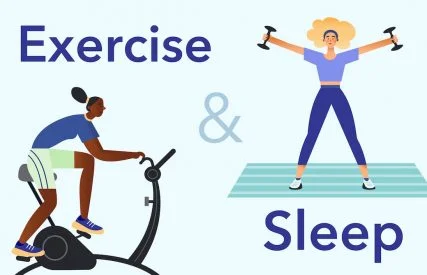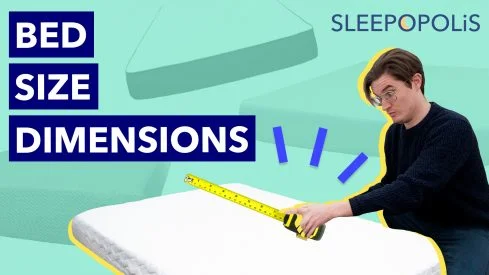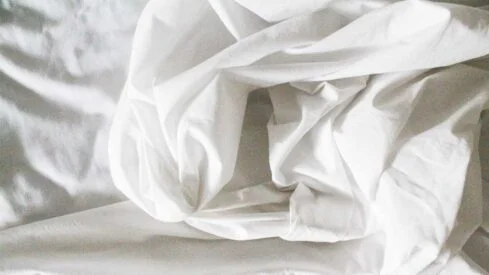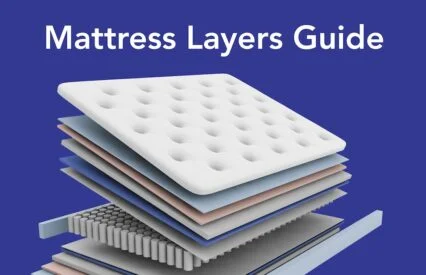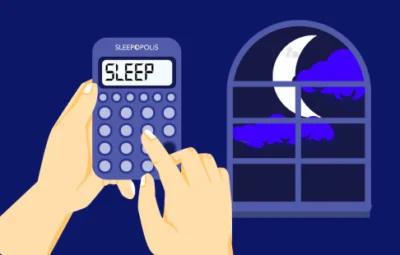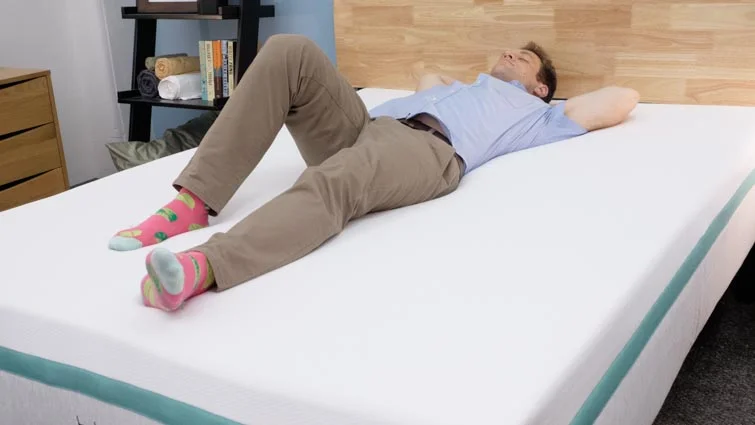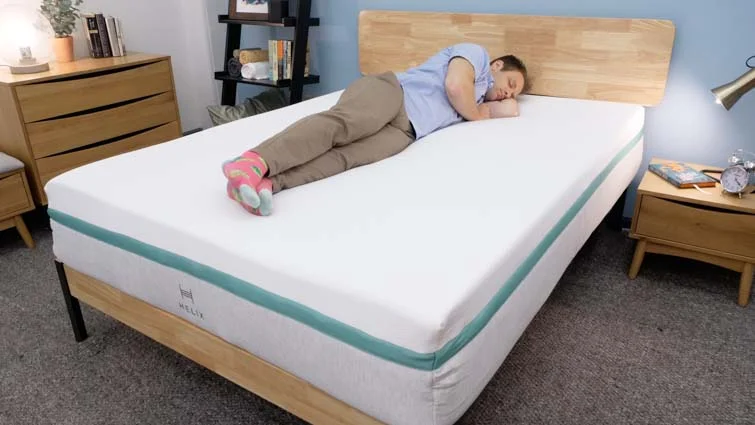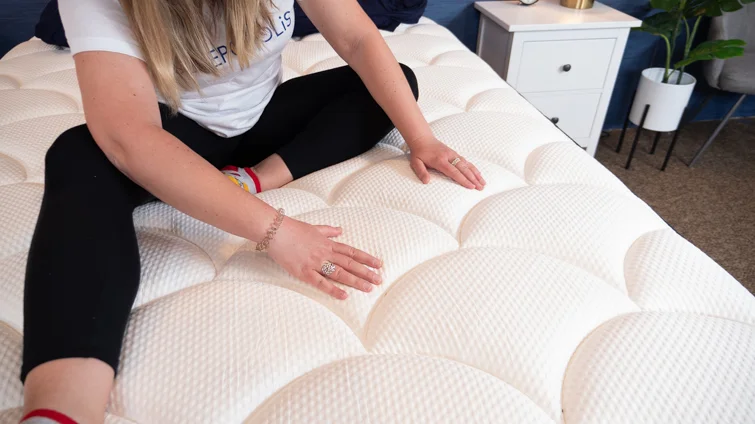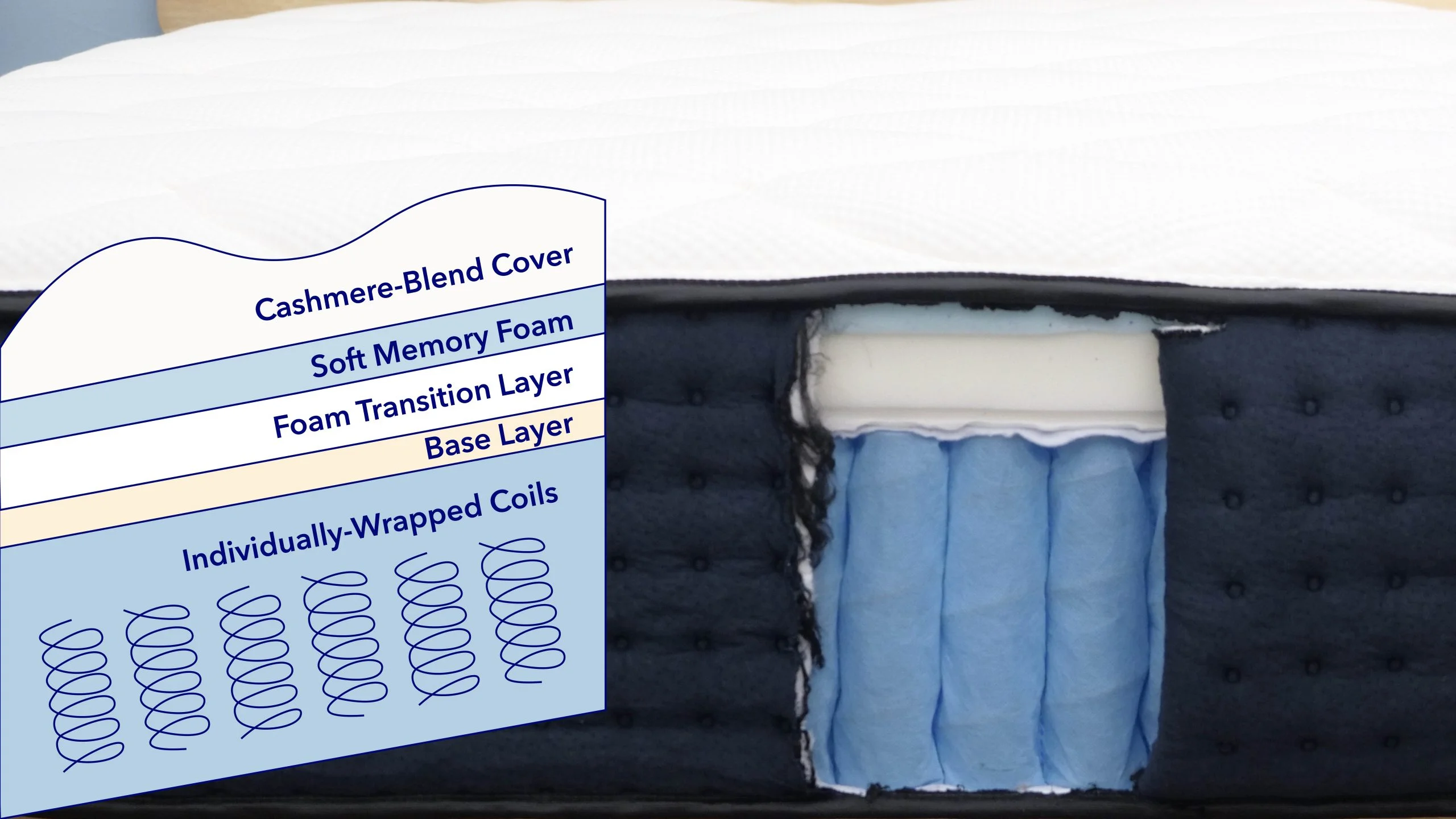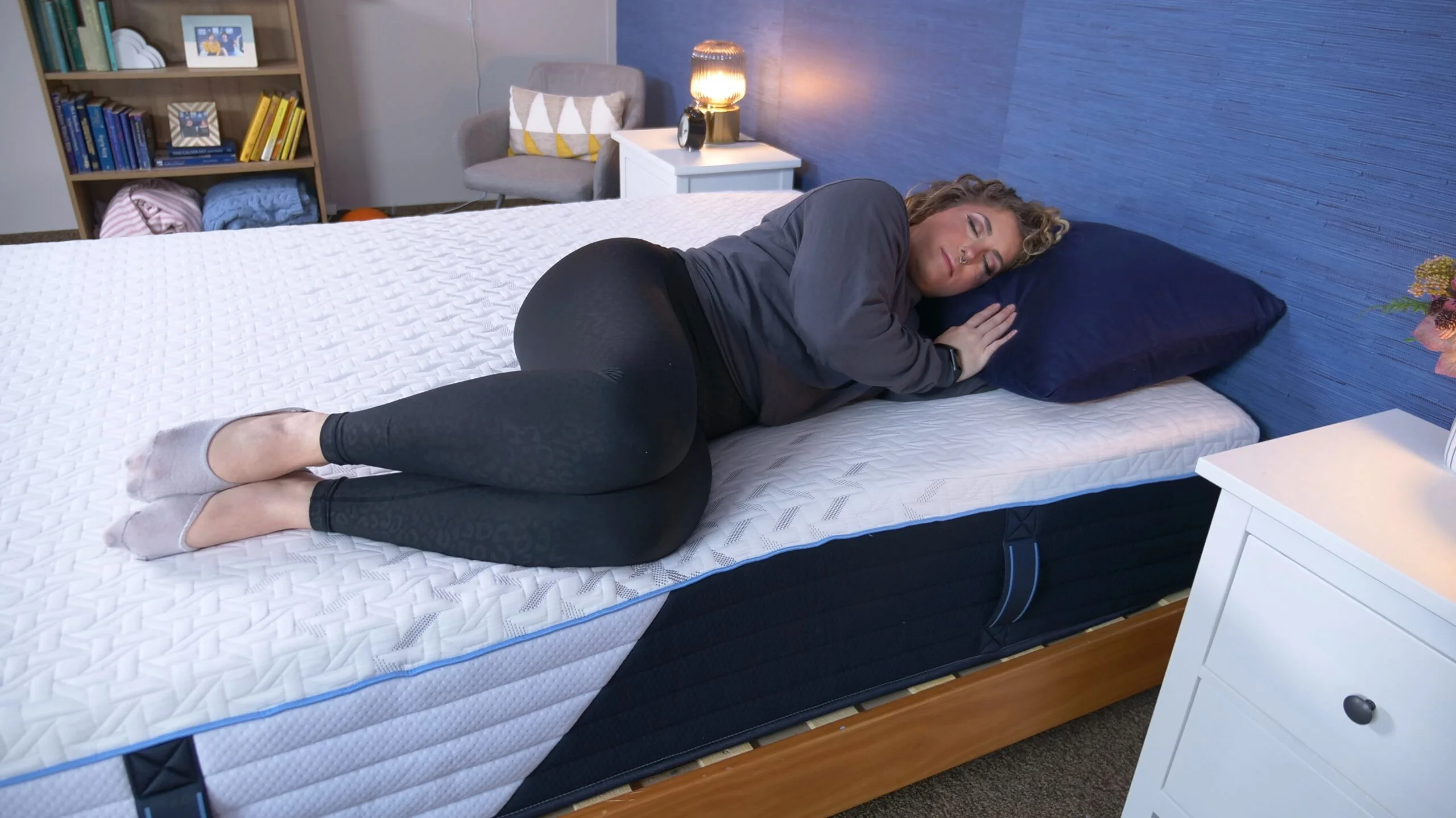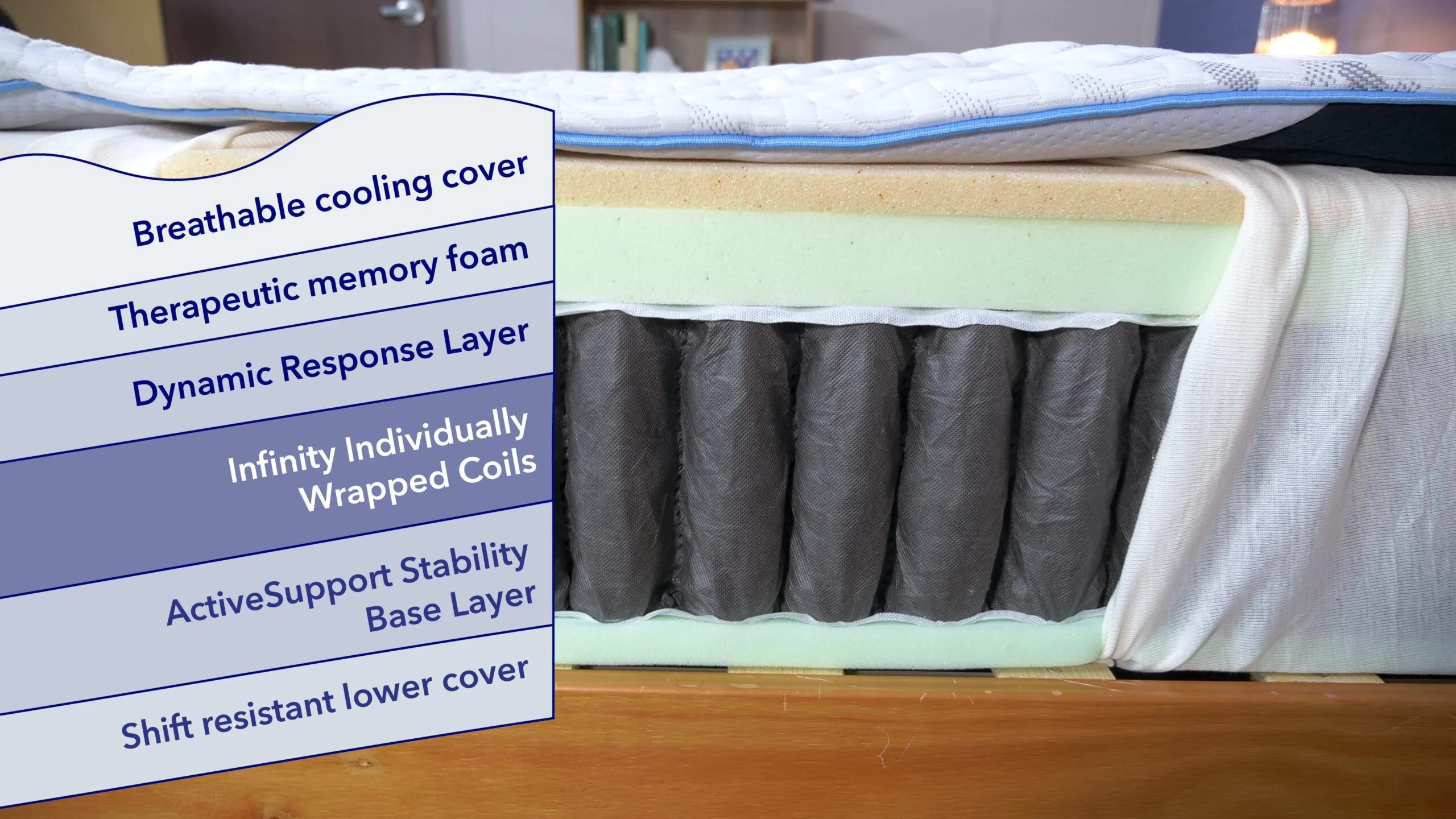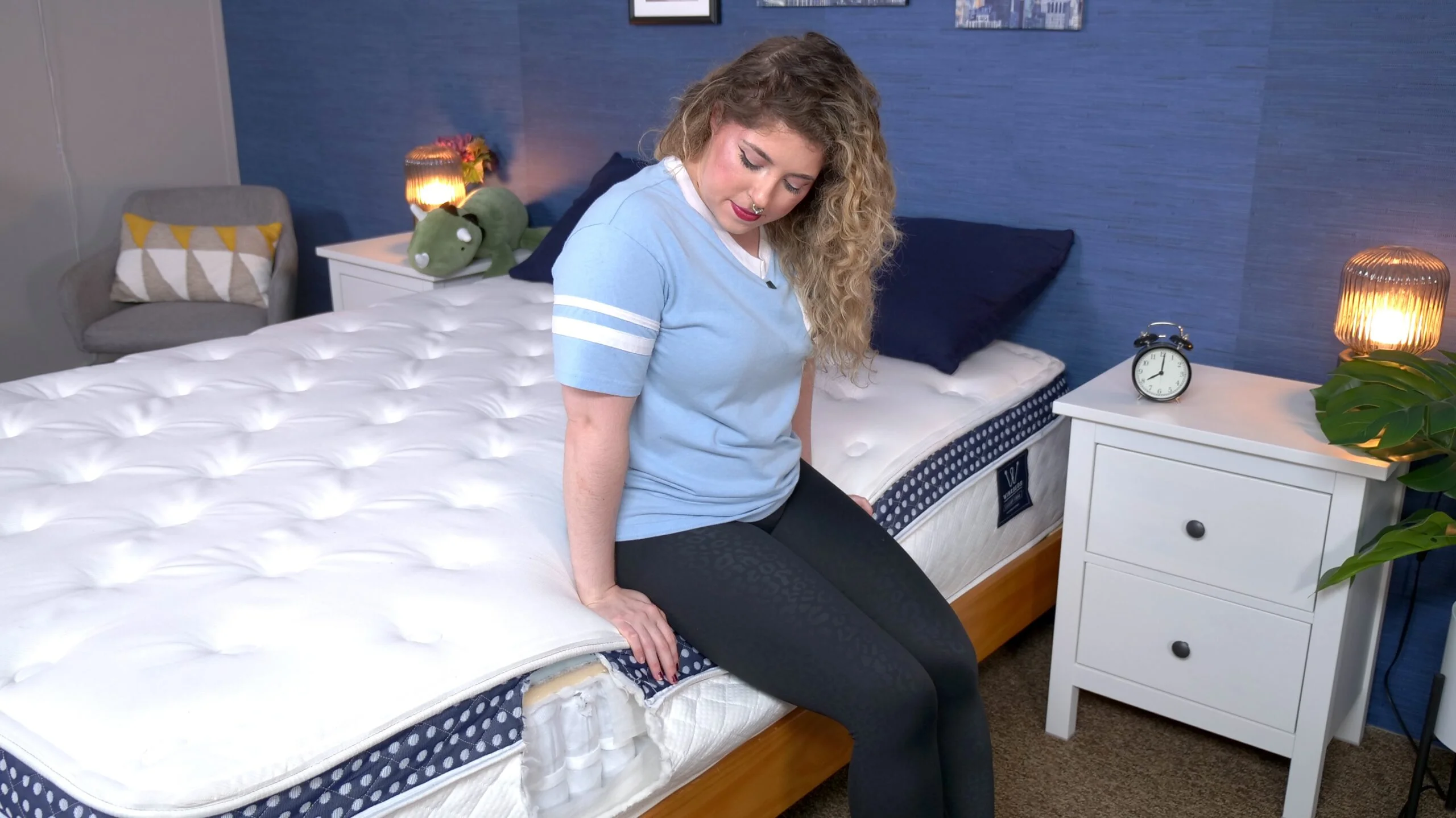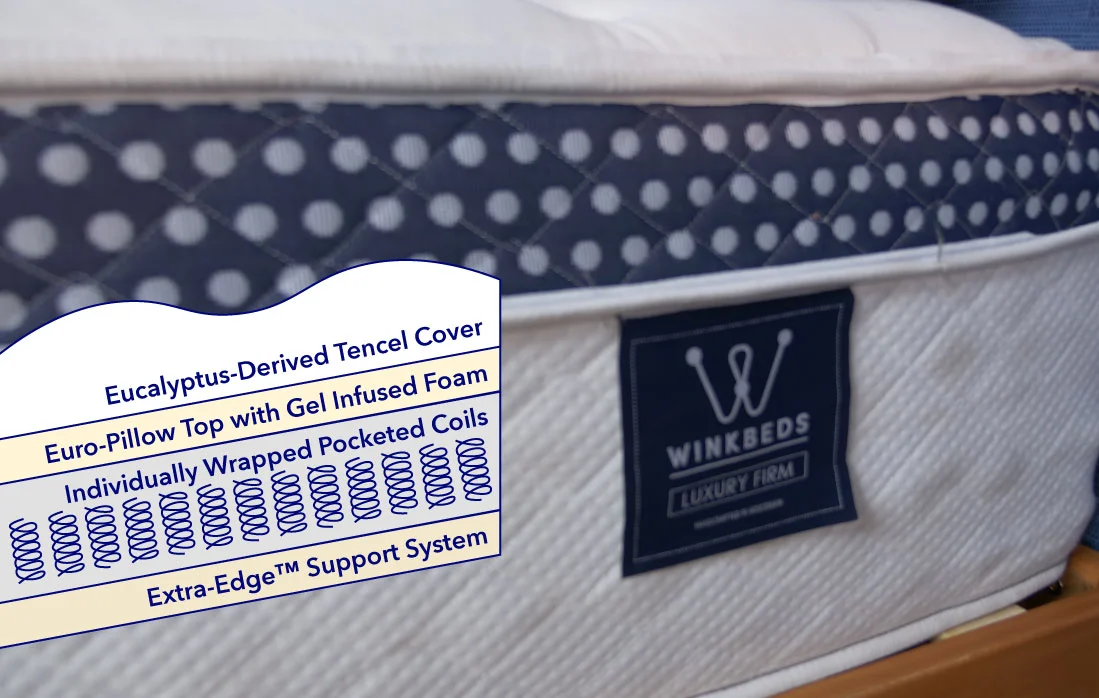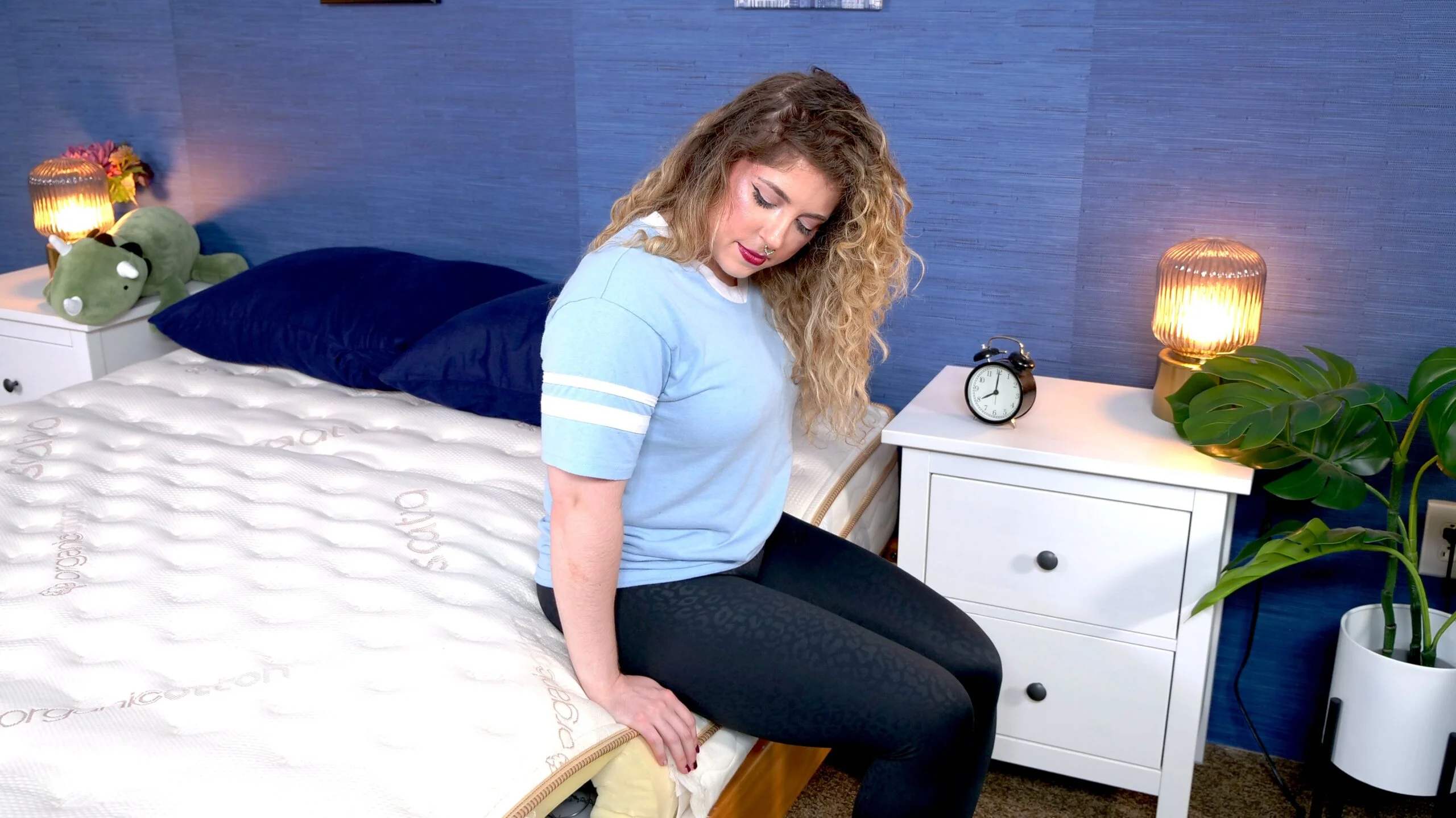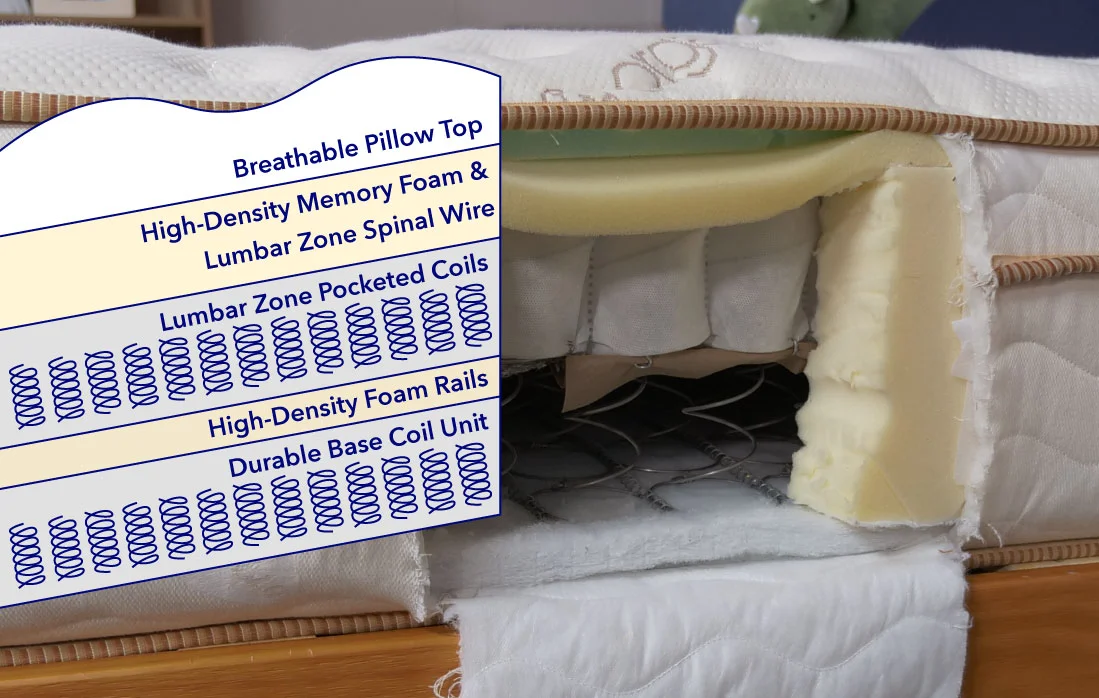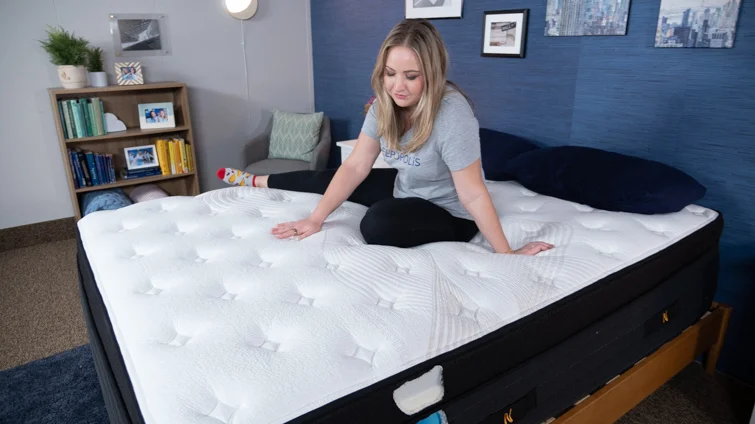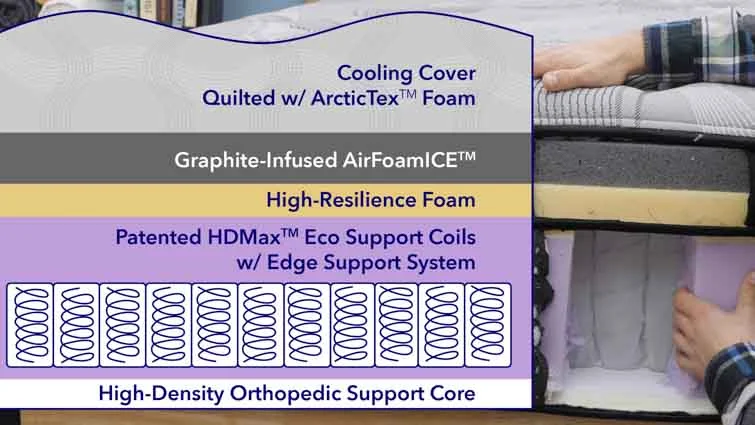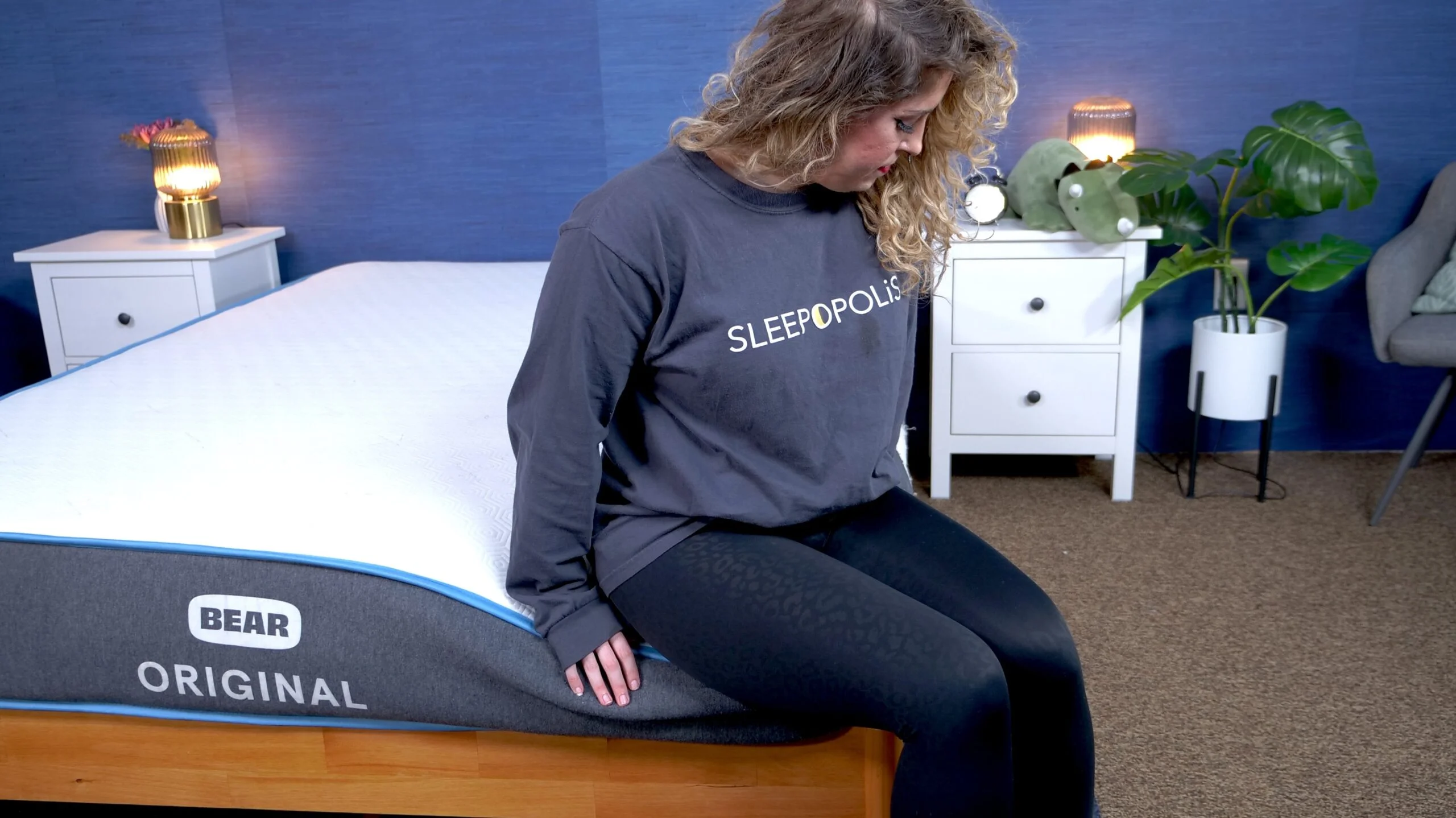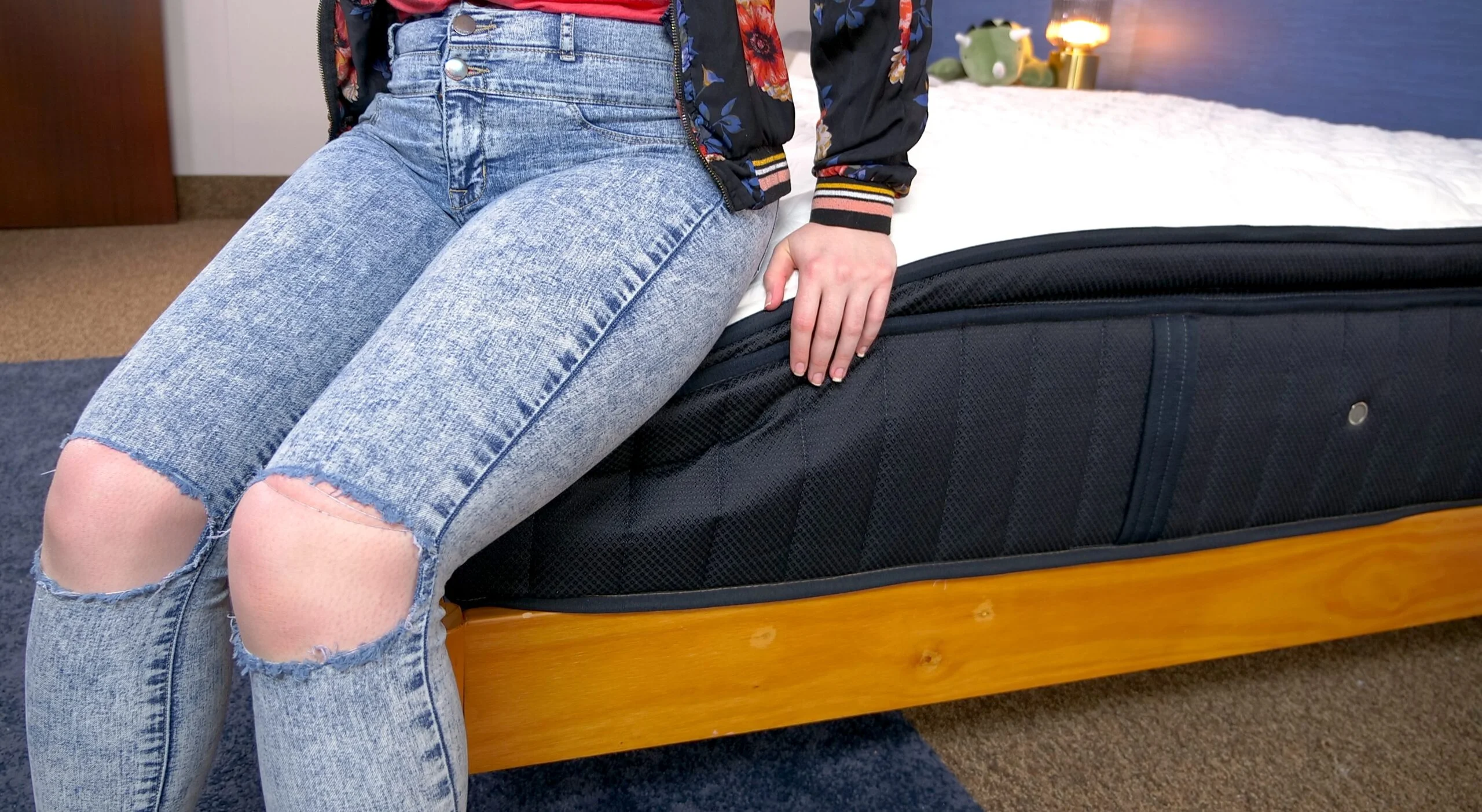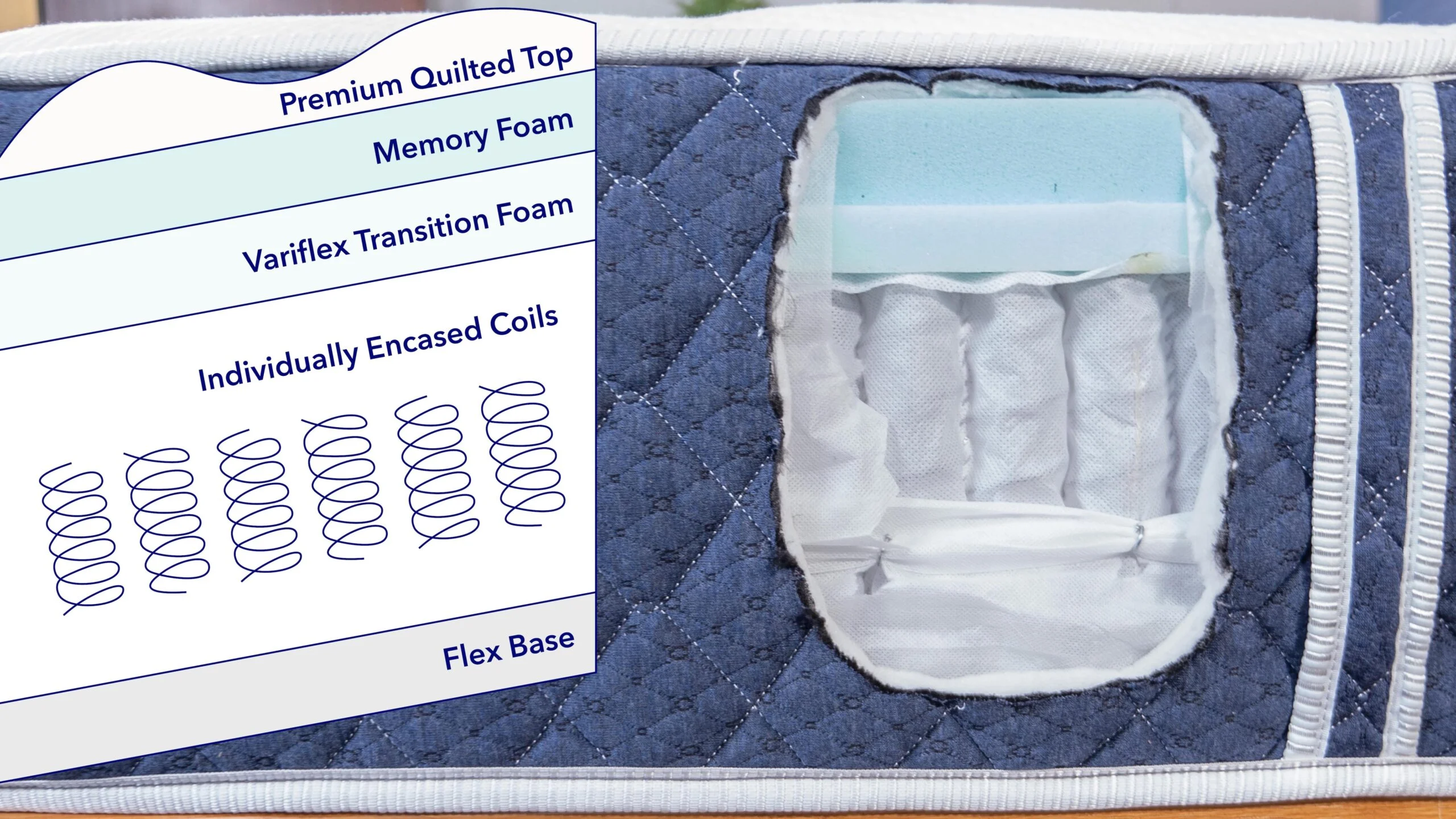Before reading about the best mattresses for lightweight sleepers, you might be wondering what the term “lightweight sleeper” even means. Well, here at Sleepopolis, we classify a lightweight sleeper as anyone who weighs 130 pounds or less. Because these sleepers have a lower body weight than average, they have a different scale when it comes to determining a mattress’s firmness. Typically, all mattresses are going to feel slightly firmer to these sleepers, since they have less body weight that is sinking into the bed and being cushioned by its layers. Because of this, lightweight sleepers have to think a little bit harder about what mattress they’re buying before they take the leap, especially if they are shopping online.
As you might know if you’ve read other Sleepopolis mattress roundups, a sleeper’s mattress decision is hardly ever based on one factor alone. While a lightweight sleeper may be looking for a slightly less firm mattress to make sure they don’t feel like they’re sleeping on a board, they might also want to find a mattress that is great for joint pain, motion transfer, or cooling.
All of the mattresses on this list have gone through multiple tests that determine not only their firmness, but a series of other factors that relate to body type, preferred sleeping position, and whether or not the customer is sleeping with a partner or a pet. This way, you’re not only learning about mattresses that are great for a typical lightweight sleeper — you’re also finding a mattress that’s great for you.
Sleepopolis’ Best In Rest — Lightweight Sleepers
We chose the Helix Sunset as the best mattress for lightweight sleepers because of its versatility and pressure-relieving performance. The Sunset features Memory Foam Plus, a memory foam designed by the brand to alleviate pressure during the night. And based on our pressure map test results, it really works. Many lightweight sleepers find it challenging to find a mattress that’s firm enough to keep them supported, yet soft enough to give them ample cushioning around their sensitive joints; the Helix Sunset is a home run on both fronts.
The Best Mattresses for Lightweight Sleepers 2025
- Best Overall – Helix Sunset
- Best Mattress for Lightweight Sleepers with Joint Pain – DreamCloud
- Best Mattress for Lightweight Couples – Nectar Hybrid
- Best Cooling Mattress for Lightweight Sleepers – WinkBed
- Best Mattress for Lightweight Stomach Sleepers – Saatva
- Best Mattress for Lightweight Side Sleepers – Nolah Evolution
- Best Memory Foam Mattress for Lightweight Sleepers – Bear
- Best Hybrid Mattress for Lightweight Sleepers – Brooklyn Bedding Signature Hybrid
Need help finding the right mattress?
Compare Best Mattresses for Lightweight Sleepers
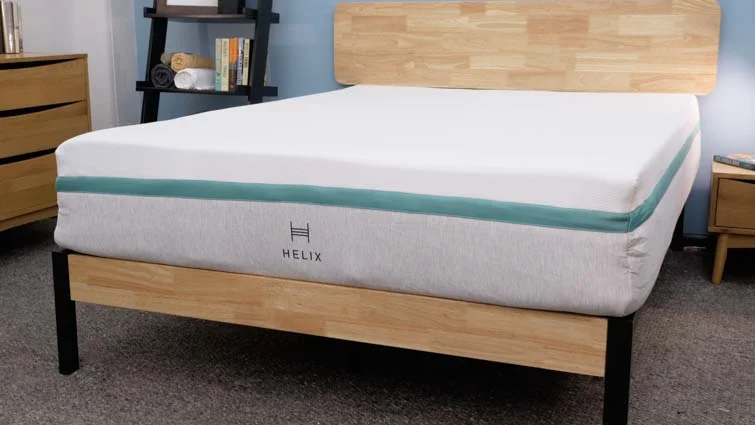 | 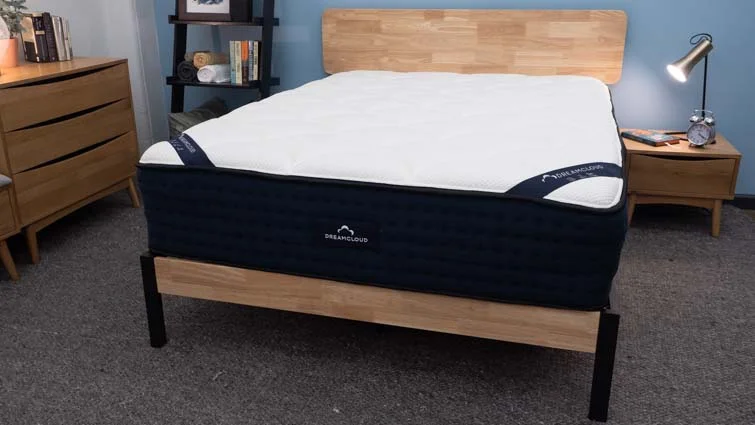 | 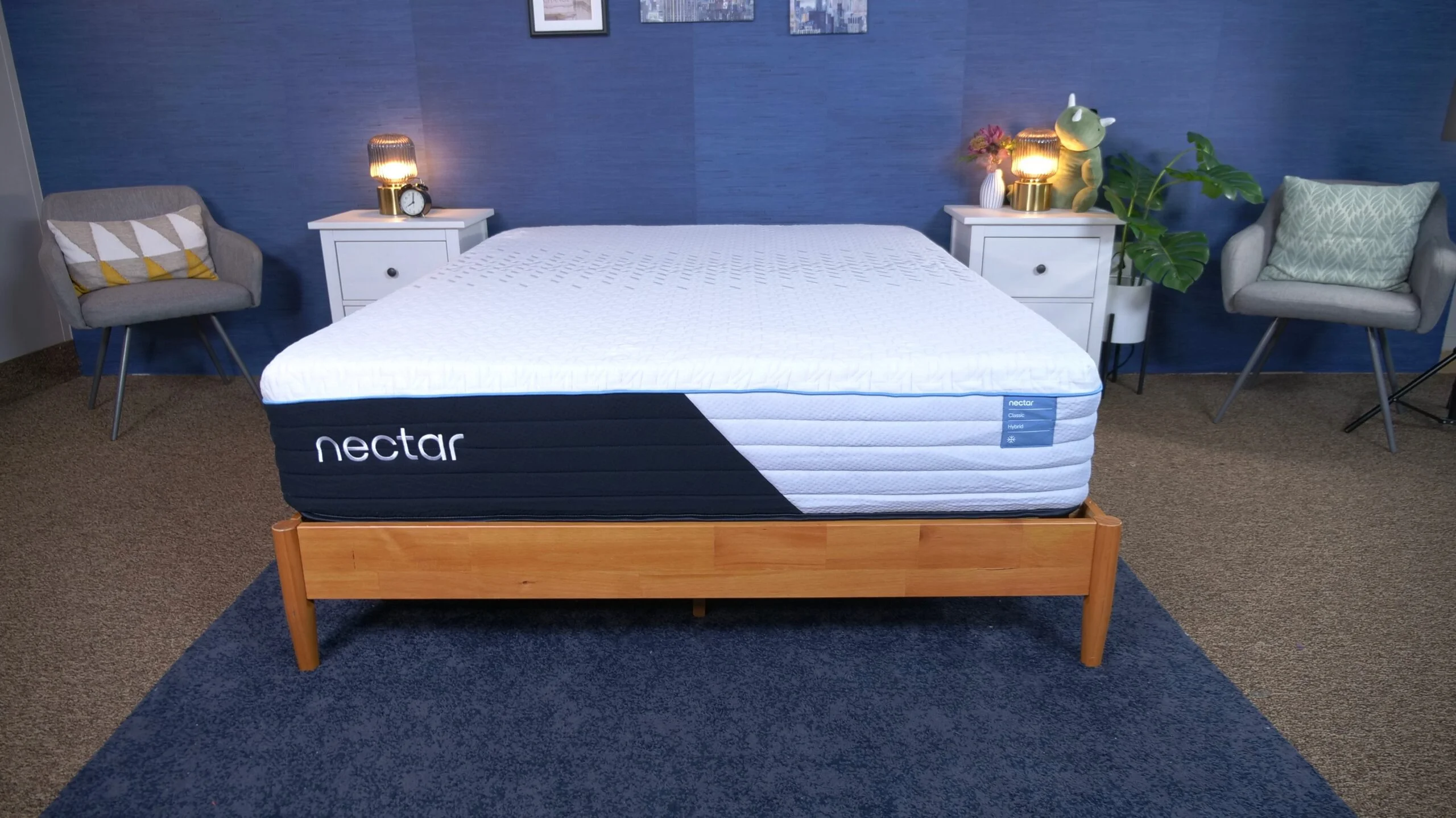 | 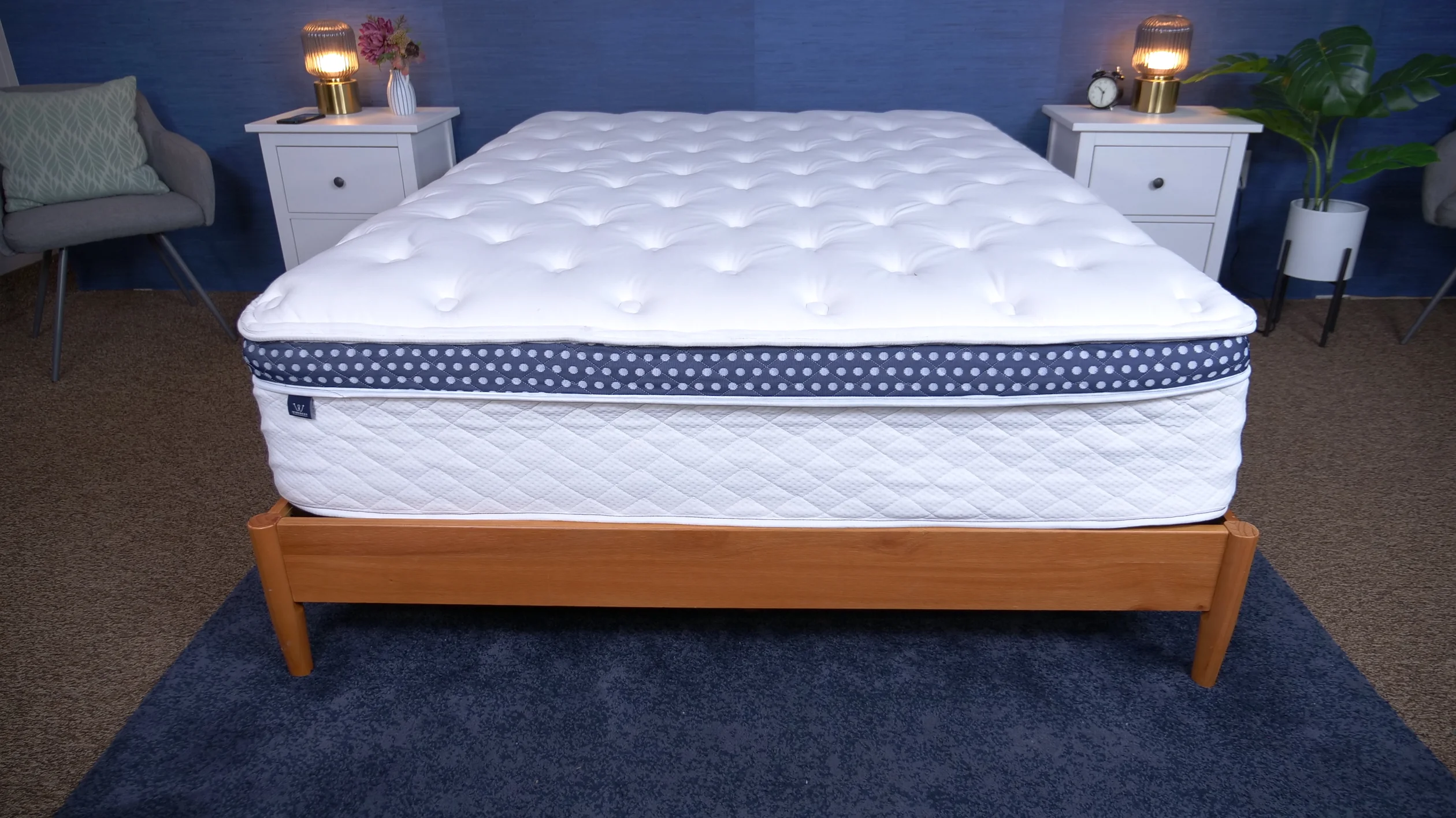 | 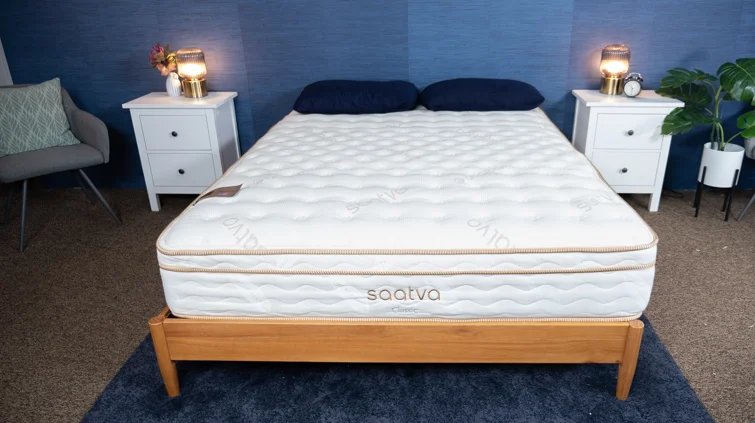 | 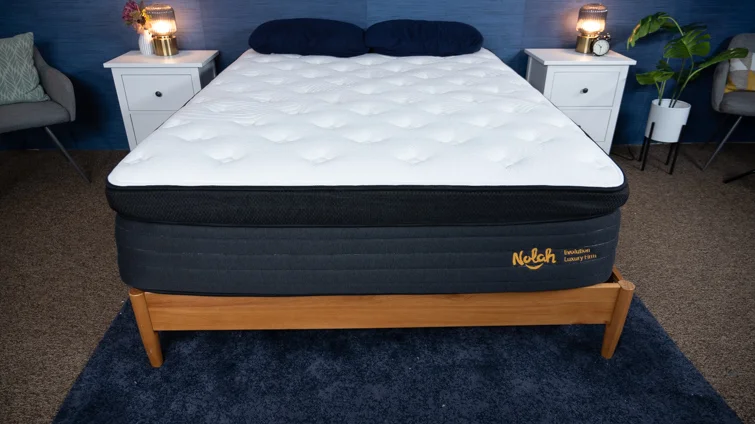 | 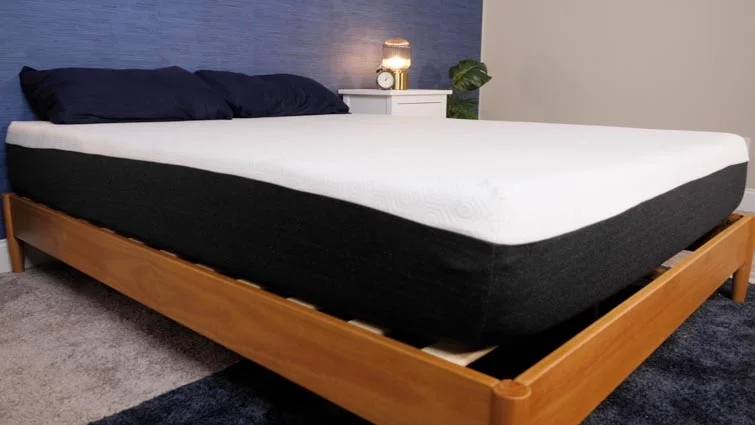 | 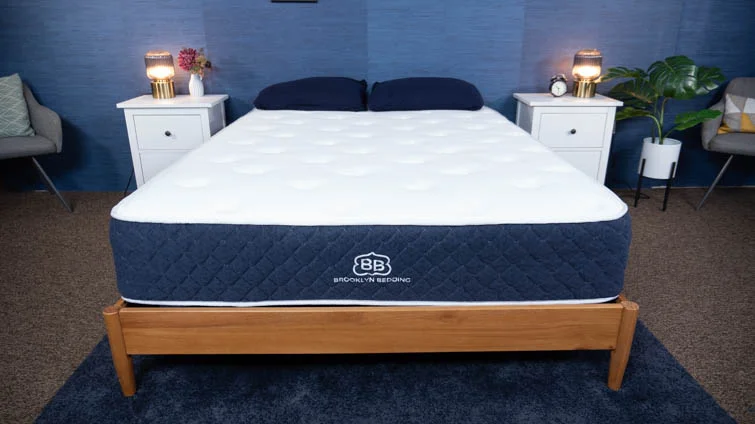 | |
| Helix Sunset Mattress | DreamCloud Original Mattress | Nectar Classic Hybrid | WinkBed Mattress | Saatva Classic | Nolah Evolution Hybrid Mattress | Bear Original Mattress | Brooklyn Bedding Signature Hybrid | |
| Rating | ||||||||
| Firmness | Soft: 5.5/10 | Medium-firm: 6.5/10 | Medium-soft: 6/10 | Firm: 7/10 | Multiple firmness options | Multiple firmness options | Firm: 7/10 | Medium-firm: 6.5/10 |
| Material | Hybrid | Hybrid | Hybrid | Hybrid | Innerspring | Hybrid | Foam | Hybrid |
| Cooling | — | — | — | |||||
| Best For | Side Sleepers, Back Sleepers, Joint Pain | Back Sleepers, Stomach Sleepers, Hot Sleepers, Seniors | Side Sleepers, Back Sleepers, Stomach Sleepers, Hot Sleepers, Back Pain | Side Sleepers, Back Sleepers, Stomach Sleepers, Hot Sleepers, Back Pain | Back Sleepers, Stomach Sleepers, Hot Sleepers, Back Pain, Seniors | Side Sleepers, Back Sleepers, Hip Pain, Seniors | Back Sleepers, Stomach Sleepers, Hot Sleepers, Hip Pain | Side Sleepers, Back Sleepers, Hip Pain, Couples |
Best Mattresses for Lightweight Sleepers Video Review

What We Look For In The Best Mattresses For Lightweight Sleepers
Softness and Comfort
If you are looking for the best mattress for a lightweight sleeper, we know one of the first things you might look for is how soft, plush, and comfortable the mattress is. We want to help you find the most comfortable mattress, so we tested the softness of each of the mattresses on this list ourselves using our firmness scale, which ranks firmness from 1-10, with 1 being the softest, to help you find exactly what you are looking for.
Pressure Relief
Regardless of how much you weigh, pressure relief is important, but pressure relief for lightweight sleepers may be different than for heavier sleepers, so we tested the pressure relief of each of these mattresses using a pressure map to help you find the best mattress for your specific needs and wants.
Motion Isolation
Motion isolation is essentially how much movement you can or can’t feel in the bed when you’re laying in it. Everyone wants to get the best sleep they can, and one way to do that is to find a mattress with good motion isolation so you aren’t woken up by other people or pets moving in the bed. We made sure to test the motion isolation properties of each of these mattresses using a ball drop test and a sort of seismograph to help you find the best mattress for you.
Best Overall – Helix Sunset
The Helix Sunset is the softest model in Helix’s mattress collection. This hybrid mattress is constructed with two layers of soft foam and a layer of individually wrapped coils. The top layer of memory foam is made from Copper Gel Memory Foam and High-Grade Helix Response Foam. Together, these soft foams work to gently cushion the sleeper’s most sensitive joints. The layer of coils below provide, lift, support, and a bit of bounce. We think this mattress is a great pick for side sleepers, who typically need a soft mattress to cradle their hips and shoulders.
What our tester says:
“The standard Helix Sunset model has a typical memory foam feel that should work well for back and side sleepers. It excels at being pressure-relieving around the joints, especially the shoulders, hips, and knees.” – Nichole Mondshein, lead reviewer and staff writer
Expert Opinion
The Helix Sunset is our top pick for lightweight sleepers because of its versatility and pressure-relieving capabilities. On the Sunset, lightweight sleepers who prefer to sleep on their back or side should fare well because of its combination of solidity and sinkage.
The Helix Sunset is constructed with a comfort layer that includes Memory Plus Foam. This is a special Helix-brand foam designed to relieve joint pressure during the night. And from the results of our pressure map test, it’s working. The Helix Sunset showed great results, lighting up entirely blue and green for back, shoulder, and hip pain. This proves that no matter your sleeping position, the Helix Sunset is there to alleviate both pressure and pain while you’re asleep.
What our tester says: “The Sunset is a great option for side sleepers. The firmness level means that there should be plenty of plush pressure relief for these folks.” – Bridget Chapman, former senior product editor
Best for Joint Pain – DreamCloud
With soft foam and a sturdy layer of innerspring coils, the DreamCloud strikes a balance between comfort and support — a little bit of contouring up top and on-top-of-the-bed feel that comes from the bottom. It’s a fairly firm mattress that we think is most comfortable for back sleepers. It also has some luxury touches such as a cashmere-blend cover that are reminiscent of a high-end hotel. Learn more in our DreamCloud video review.
What our tester says:
“I really like how luxurious this mattress feels and how it could work for a variety of sleepers. Along with that, I found that the breathable cashmere cover helps the DreamCloud sleep cool throughout the night. Thanks to its medium-firm to firm support, I think the DreamCloud is a durable mattress. It balances support with plenty of pressure relief for back sleepers.” – Bridget Chapman, former Sleepopolis senior product editor
Expert Opinion
When looking for the best mattress to help lightweight sleepers alleviate their joint pain, the DreamCloud bed stood out because it performed well on our pressure map tests in all sleeping positions. The DreamCloud is a luxury hybrid mattress, meaning it has both coils and foams to combine support and pressure relief. This is a big plus for stomach and back sleepers because they should get the support they need for a neutral spinal alignment. Likewise, side sleepers should get the cushioning and sinkage they need to alleviate pain around their joints on this mattress.
What our tester says: “I really like how luxurious this mattress feels and how it could work for a variety of sleepers. Along with that, I found that the breathable cashmere cover helps the DreamCloud sleep cool throughout the night.” – Bridget Chapman, former senior product editor
Best for Couples – Nectar Hybrid
The Nectar Hybrid is a medium-firm mattress with a durable hybrid construction. It works especially well for back sleepers, as it provides enough support to keep their spines in neutral alignment. The hybrid design also gives it nice breathability and responsiveness, meaning it stays cool as you sleep and is easy to move around on.
What our tester says:
“I think back sleepers should be thrilled by the combination of pressure relief and support the Nectar Classic Hybrid offers. Couples should appreciate the Nectar Classic Hybrid’s edge support, cooling capabilities, and ability to isolate motion.” – Nichole Mondshein, lead reviewer and staff writer
Expert Opinion
We rated the Nectar Hybrid a 6.5 on our mattress firmness scale, which is exactly the same as the industry standard for a medium-firm mattress. But lightweight sleepers should experience it as a little bit firmer, which means the materials should help keep their spine in a neutral alignment. At the same time, the foams are soft enough to provide pressure relief to their lumbar region.
When it comes to couples, typically we look at four factors: motion transfer, sex, cooling, and edge support. The Nectar Hybrid scored well on our motion isolation test, which involves dropping a steel ball from different heights onto the mattress and measuring the vibrations with a seismometer. The Nectar Hybrid had very low vibrations, so couples shouldn’t be disturbed by their partner’s tossing and turning during the night. However, its ability to isolate motion means that it’s not super bouncy, so it may not be the best mattress for sex.
We did find that the Nectar Hybrid has strong edge support, so you shouldn’t feel like you’re sliding off the bed when you sleep near the side, plus it allows you and your partner to spread out and use the whole surface of the mattress. And as for temperature, the Nectar Hybrid includes cooling technology inside of its layers, which we’ll talk about more in the pros section below.
What our tester says: “I really like how I felt comfortable sleeping on my back and side on this mattress. The top foams have a slower-moving feel, which is great for pressure relief, and the coils bring added support and durability to the bed.” – Bridget Chapman, former senior product editor
Best Cooling Mattress – WinkBed
The WinkBed is a luxury hybrid mattress. It has a similarly supportive and sturdy feel to a traditional innerspring mattress, but upgrades like a Euro top and cooling Tencel cover give it a touch of modern luxury. Available in three firmness levels, there is a WinkBed for just about every sleeper. And a responsive and bouncy feel makes it a great pick for combination sleepers. Learn more in our video review.
What our tester says:
“If you like the feel of a traditional innerspring mattress, the WinkBed could work for you. Since this bed offered great pressure relief around my lumbar region, I’d also recommend it to folks who suffer from lower back pain.” – Nichole Mondshein, lead reviewer and staff writer
Expert Opinion
The WinkBed is a luxury hybrid mattress constructed with a plush pillow top and ultra-supportive coils. It also comes in three different models (Softer, Luxury Firm, and Firmer), so customers really can pick the firmness level that’s right for them. For lightweight sleepers, we recommend the Softer. They should get a good balance of pressure relief from the plush Euro pillow top and support from the reinforced coils.
In terms of cooling, The WinkBed’s most notable feature is its extra-tall section of coils. These help to create space for air to flow through the hybrid construction. The layer of memory foam above the coils also has an infusion of gel for added cooling. Both of these features helped us keep a low temperature as soon as we laid down on the WinkBed, so this mattress should be an excellent choice for hot sleepers.
What our tester says: “I really like the bouncy support this mattress offers. It should be a hit with combination sleepers who need some mobility to change positions at night. Anyone who likes a more traditional innerspring feel should find a lot to love in the WinkBed.” – Bridget Chapman, former senior product editor
Best for Stomach Sleepers – Saatva
The Saatva’s coil-on-coil construction provides a classic innerspring feel. It’s a good option for combo sleepers, who will want to feel free to switch positions and avoid feeling “stuck” in the mattress. It comes in three firmness levels, so you should be able to find one that suits your needs. The white glove delivery Saatva provides is an added perk and will save you the headache of getting rid of your old mattress (they take it away for free!). For more information, watch our video review.
What our tester says:
“I think the Saatva is a great option for back sleepers, as the Luxury Firm model provides enough cushioning for their lumbar region, but also lots of support to keep their spine in a neutral alignment.” – Nichole Mondshein, lead reviewer and staff writer
Expert Opinion
It can be difficult to find a suitable mattress for stomach sleepers. Even lightweight stomach sleepers put more pressure on a bed than other sleeping positions, so they need something that’s going to provide comfort without letting the hips sink too far into the material, which can throw the spine out of alignment. However, the Saatva Classic scored a 7 on our firmness scale, making it firmer than the industry standard for a medium-firm mattress. Because of this, lightweight stomach sleepers should have enough lift beneath them to keep their hips in line with their shoulders.
The Saatva also comes in three firmness models: Plush Soft, Luxury Firm, and Firm. We tested out the Luxury Firm model and felt very supported on its coil-on-coil construction. Lightweight stomach sleepers should enjoy its traditional innerspring feel, and the additional three-inch Euro top should provide just enough pressure relief for their joints and lumbar region. These folks might also be comfortable on the Plush Soft model.
What our tester says: “I’d recommend trying the Firm model if you’re a strict stomach sleeper. A firm mattress helps keep the hips and shoulders aligned, which is important for avoiding back pain.” – Bridget Chapman, former senior product editor
Best for Side Sleepers – Nolah Evolution
The Nolah Evolution’s hybrid construction offers the cushioning of memory foam with the responsiveness of coils. The Luxury Firm model is a good option for side and back sleepers due to its medium-firm feel, though there are Plush and Firm versions as well. Those who share a bed may also appreciate its low motion transfer, so you won’t be disturbed by a partner’s movements and its solid edge support to allow you to maximize surface area. For more information, check out our video review.
What our tester says:
“I laid down to rest on this mattress on my back — my primary sleep position. I felt comfortable, but also appreciated the cozy, plush top of the bed. After some time lying on my back, I switched over to my side. I didn’t find this position quite as comfortable, as I did feel some slight pressure buildup in my shoulder.” – Amelia Jerden, senior staff writer
Expert Opinion
Side sleepers and lightweight sleepers are similar in that they need a mattress with a ton of softness and contouring. For the former, it’s because they tend to experience beds as firmer than other types of sleepers. And for the latter, they require deep pressure relief at the shoulders and hips. So if you’re a lightweight side sleeper, we recommend an especially soft mattress like the Nolah Evolution. lt’s offered in three different firmnesses, and we naturally recommend their Plush model. Lightweight side sleepers should experience plenty of contouring at the shoulders and hips — the areas of the body where they put the most pressure.
While testing the Nolah Evolution’s Luxury Firm on our pressure map test, we found some fantastic pressure relief for average weight sleepers. Our tester noted the gentle contouring, especially at the shoulders. With this in mind, we feel really confident that the Plush model will suit lightweight side sleepers well, too. Just don’t forget to select the right firmness at checkout.
What our tester says: “I found this mattress to be very comfortable while laying on my side. It alleviated pressure at my shoulders and hips, and allowing for nice sinkage.” – Bridget Chapman, former senior product editor
Best Memory Foam – Bear
Even though it’s made entirely of foam, the Bear has a firm, supportive feel that should be sturdy enough for back sleepers and stomach sleepers alike. Additionally, combination sleepers should be able to easily move around on its surface. You can also pay extra for a Celliant cover that may help with cooling and muscle recovery. Learn more in our video review.
What our tester says:
“I found the double poly foam construction produced a firm, supportive feel. Though you’re likely to sink into its top layer of memory foam, this sinkage is somewhat curbed by the taut poly foam transition layer. This means most folks are going to be positioned more “on top” of the structure than “in” it.” – Nichole Mondshein, lead reviewer and mattress tester
Expert Opinion
If you’re a lightweight sleeper who’s not crazy about the firmer feel of a hybrid or innerspring mattress, you might be biased toward the hugging feel of memory foam. The all-foam Bear includes two inches of this material, which contours and relieves tension around sensitive areas. As comfortable as memory foam is, it can sometimes cause sleepers to sink too far into the bed. However, the Bear prevents this with a bottom layer of high-density support foam. When we tested out the mattress, we felt fully supported and on top of the mattress.
We rated the Bear as a 7 on our firmness scale, so it is slightly firmer than the industry standard for a medium-firm mattress, which is set at a 6.5. Once again, this is great for lightweight sleepers because it allows versatility for different sleeping positions, whether your preference is combination, back, side, or stomach sleeping. All of these folks should be comfortable on the Bear, as long as they weight 130 pounds or less.
What our tester says: “I really appreciate the firm and responsive feel of the Bear mattress. Its combination of support and pressure relief makes it an great option for back sleepers struggling with back pain. I also really like the Bear’s Celliant cover.” – Bridget Chapman, former senior product editor
Best Hybrid – Brooklyn Bedding Signature Hybrid
The Brooklyn Bedding Signature Hybrid mattress combines a foam comfort layer and sturdy coils. This combination of materials makes it bouncy and easy to move around on. It comes in three firmness levels, and we recommend the Medium model for most back sleepers. It’s a great choice for shoppers who are looking for a new mattress on a budget. For more information, check out our video review.
What our tester says:
“Given that the Signature Hybrid has some excellent bounce, I’d highly recommend this mattress for combination sleepers who often change positions multiple times throughout the night. I also think the Signature Hybrid could be a great fit for couples. You shouldn’t be overly disturbed by a restless partner on this bed, and it has nice, firm edge support.” – Nichole Mondshein, lead reviewer and staff writer
Expert Opinion
Like many of the other hybrid mattresses on this list, the Brooklyn Bedding Signature combines individually wrapped coils with comforting foam. The company actually uses their patented TitanFlex foam, which we felt delivered the feel of traditional memory foam, but with more responsiveness and cooling. Brooklyn Bedding also sells their mattresses in three firmnesses: Soft, Medium, and Firm.
We personally recommend the Medium version of the Signature Hybrid to lightweight back and stomach sleepers, while side sleepers might do better with the Soft model. This is because the firmer mattress models will help back and side sleepers to feel more “on top” of the mattress for a neutral spinal alignment, while the Soft model will allow for more sinkage around sensitive areas (i.e. the hips and shoulders) for lightweight side sleepers.
What our tester says: “I really like how the Brooklyn Bedding Signature Hybrid comes in three different firmness levels. It allows for all kinds of sleepers to find the right fit for them.” – Bridget Chapman, former senior product editor
How Do I Know If I’m a Lightweight Sleeper?
Lightweight sleepers: 130 pounds or less
Average weight sleepers: 130 pounds–250 pounds
Heavier sleepers: 250 pounds or more
How to Choose a Mattress for Lightweight Sleepers
Firmness
Lightweight sleepers can select from a variety of firmnesses. However, most lean towards softer mattresses. These sleepers don’t require the same support as heavier sleepers, so a soft mattress will usually still provide adequate sturdiness and comfort. If you’re a lightweight sleeper who prefers a firmer mattress, then look for a thin comfort layer. The thinner comfort layer allows you to compress into the firmer part of the construction.
At Sleepopolis, we test firmness by rating it on a scale of one to 10, with one being the softest and 10 being the firmest. Usually, we have several Sleepopolis employees test these mattresses, and then we find the mean of their rankings to determine the overall firmness score. This helps us give the average sleeper a good idea of where this mattress falls in firmness compared to the industry standard for a medium-firm mattress, which sits at a 6.5 on our firmness scale.
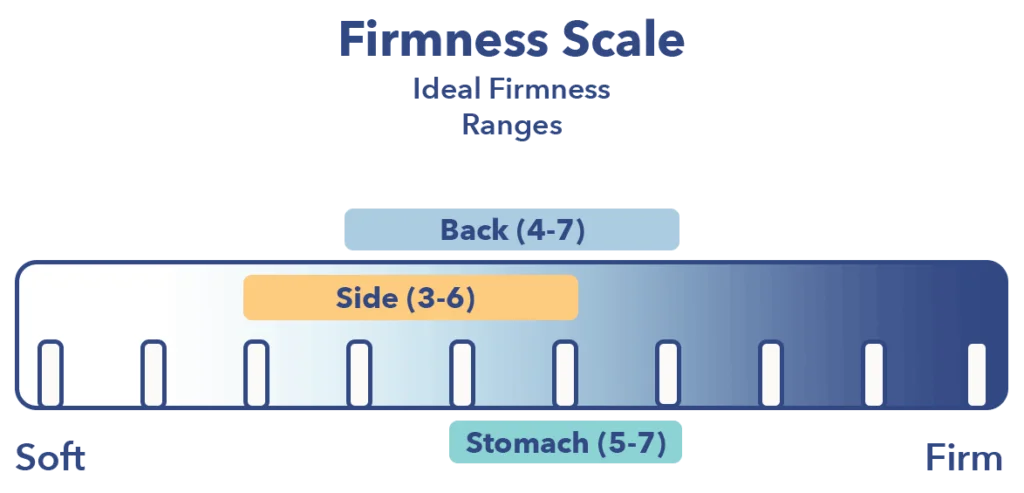
So, if you’re a lightweight sleeper who has a specific firmness in mind, make sure that you take into account the fact that the mattresses on this list might feel slightly firmer to you because of your body type. Because of this, our firmness scale might not be entirely accurate when you lay on the mattress yourself.
Sleeping Position
Keep in mind that it’s important to consider sleeping position in conjunction with body type. Heavyweight side sleepers are going to need a much firmer and more supportive mattress than lightweight sleepers, because heavyweight sleepers use more weight to press into the mattress layers.
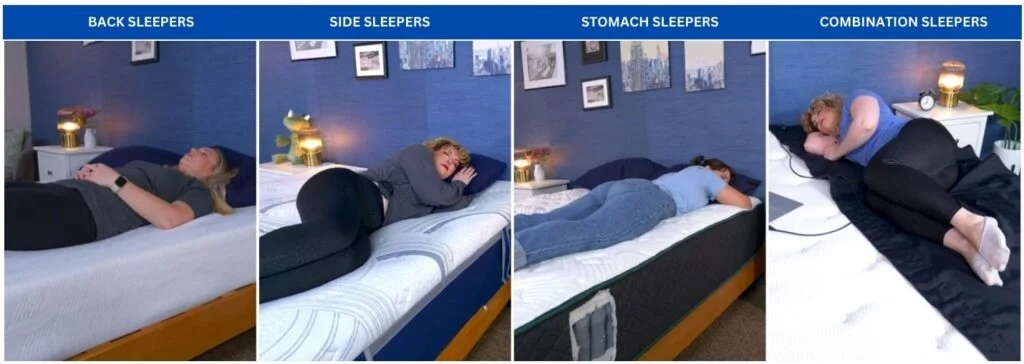
Side sleepers: Pressure relief is the most important thing to remember about a good mattress for side sleepers. With the way they position their bodies, pressure builds up around the hips and shoulders. A mattress with a softer construction or a thicker comfort layer can ease these pain points and ensure a restful sleep.
Side Sleepers
Pressure relief is the most important thing to remember about a good mattress for side sleepers. With the way they position their bodies, pressure builds up around the hips and shoulders. A mattress with a softer construction or a thicker comfort layer can ease these pain points and ensure a restful sleep.
Back Sleepers
Back sleepers: A balance of comfort and support is essential for back sleepers. They require support to prevent sinkage, but also need pressure relief at the hips and lumbar region. Most mattress types should work well for these sleepers, as long as they’re not super soft or super firm.
Stomach Sleepers
Stomach sleepers: These folks require a firmer, more supportive mattress for proper spinal alignment. Stomach sleepers need their hips to remain lifted, so it’s crucial to find a bed that’s going to prevent the waist from bowing and the back from arching. Innersprings, latex beds, and firmer hybrids do this especially well. However, lightweight stomach sleepers can get away with many foam mattresses, since they don’t require as much support.
Combination Sleepers
Combination sleepers: Because they switch positions at night, they’ll want a bed that makes it easy to move around on. Look for a responsive, bouncy construction. These can most often be found in latex, innerspring, or hybrid mattresses. However, some memory foam beds include transition layers that prevent excess sinkage and help with ease of movement.
Type of Mattresses
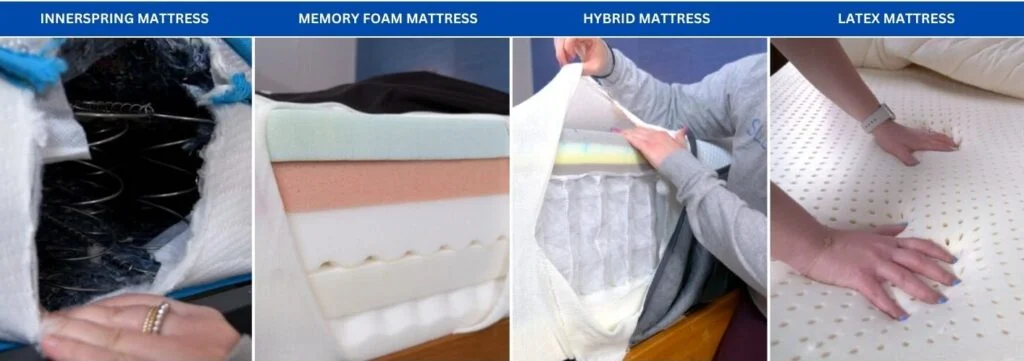
Each mattress has a different construction and utilizes different materials. With that said, it comes down to your individual wants and needs when selecting the best mattress for lightweight sleepers. As a general rule, softer mattresses (like memory foam mattresses) are going to be better for lightweight sleepers; they simply don’t need the support of a hybrid, latex, or innerspring, as heavy sleepers do.
Alright, let’s get into some of the most commonly used mattress materials:
Memory Foam
Memory Foam: Memory foam is stellar at contouring and pressure relief. This should appeal to lightweight side sleepers who require cushioning at the shoulders and hips. While some foams tend to trap heat and sag easily, companies have created cooling foams and high-density foams to work around these challenges.
Innerspring
Innerspring: These beds are known for providing unparalleled support, thanks to the inclusion of sturdy coils. For this reason, they’re fantastic for heavier sleepers or stomach sleepers. The coils allow for cooling as well, making this construction ideal for hot sleepers. Innerspring beds are often great for back pain because they offer firmer support, but since they don’t have the same level of pressure relief as a memory foam bed, they’re not the best for joint pain.
Hybrid
Hybrid: If you want a mixture of memory foam and innerspring features, opt for a hybrid. It’s the best of both worlds, including foam for pressure relief with sturdy coils at the base. Because every company has a different construction style for their hybrid mattresses, they range in firmness. Overall, these mattresses are durable, cooling, and more balanced in feel.
Latex
Latex: For an environmentally friendly option, try latex. Mattresses can include latex foam in the comfort layers for cushioning, or even in the base of the mattress for support. This material is incredibly durable, and naturally cooling. While they tend to be more expensive, the quality of these beds is impressive and often worth the cost.
Other Mattress Considerations
Cooling
If you sleep with a partner, experience hot flashes, or just want to avoid overheating in bed, opt for a cooling mattress. There are a number of options available for reasonable price points. Generally, a hybrid mattress or innerspring mattress is best. The coils used provide lots of airflow. While memory foam mattresses are known for trapping heat, many companies include cooling technology to combat this.
When we test mattresses, we use a thermal gun to understand how fast a mattress dissipates heat after our testers lay on the mattress for 10 minutes. Typically mattresses that have phase changing materials, coils, breathable covers and gels perform great in this cooling test. The heat gun helps us map out where each mattress might trap heat and how it will perform when you sleep on it. We consider a 5 degree increase fantastic cooling and an 8 degree increase great cooling.

Durability
Mattresses are an investment, which makes purchasing a durable mattress all the more important.
- Memory foam mattresses tend to last five to seven years.
- Innerspring mattresses tend to last seven to 10 years.
- Hybrid mattresses tend to last seven to 10 years.
- Latex mattresses tend to last 10 to 15 years.
However, it all comes down to the mattress construction and quality of materials. Many high-density foam mattresses can last up to 10 years, while those with weaker foams sag much faster. Be sure to look out for mattress warranties as they will give you a good idea as to how long the mattress company expects them to last, and how durable the construction is.
Motion Isolation
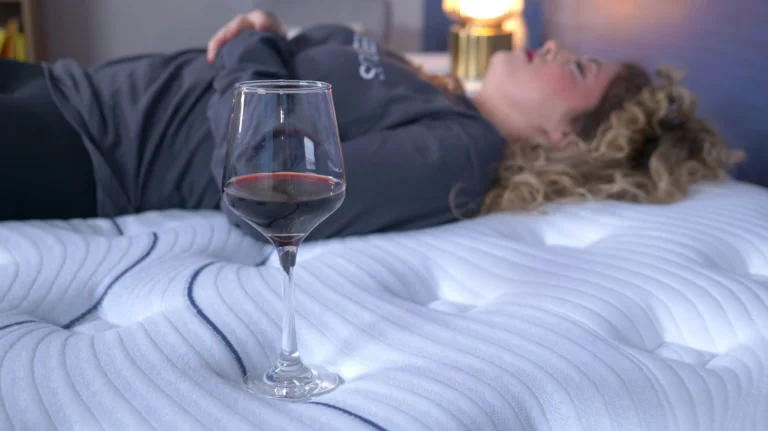
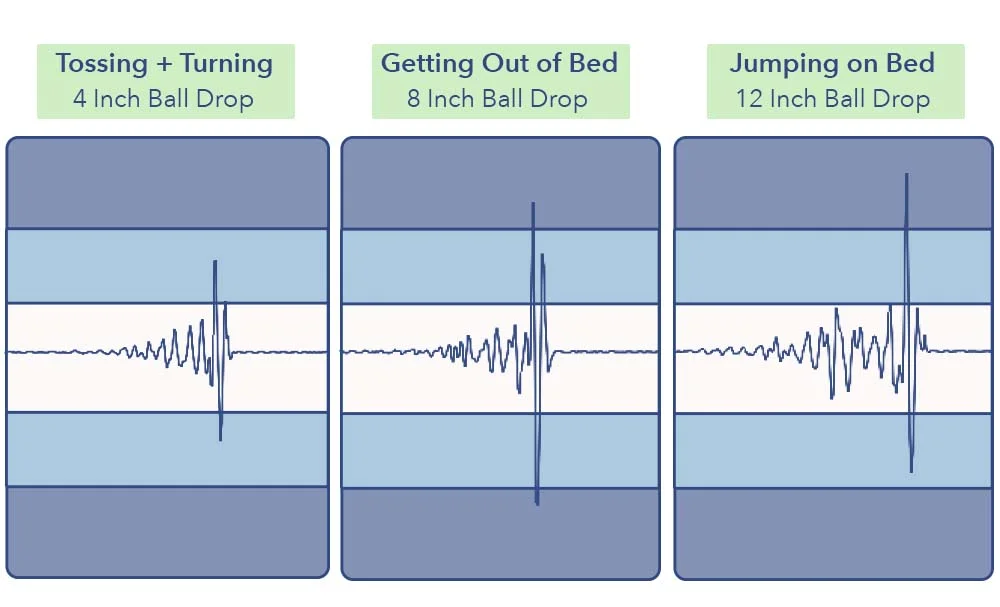
Are you a light sleeper who shares the bed with a partner or pet? If so, ensure that you take motion isolation into consideration. If a bed has high motion transfer, it’s not as likely to isolate movement. Memory foam beds or mattresses with thick comfort layers tend to be the best at motion isolation.
To test for motion isolation we perform a couple of tests to each mattress and score them out of 5. We first do a red wine test where we place a full glass of wine on one side of the mattress and rotate through various sleeping positions on the other side of the bed and see if the glass tips over.
We also use a seismograph machine to measure the amount of movement felt across the mattress when weighted, steel balls are dropped from different heights onto the bed. These tests help us score each bed for motion isolation and how they will perform for side sleepers.
Edge Support
Edge support in a mattress refers to how well the edges maintain stability when weight is applied, preventing sagging and enhancing overall usability. For lightweight sleepers, good edge support is important because it maximizes the usable sleep surface and makes getting in and out of bed easier. Additionally, strong edge support enhances comfort by preventing the sensation of rolling off, promoting better sleep quality. We measure for edge support by using a yard stick to measure the amount of sink experienced when sitting on the edge of the bed.
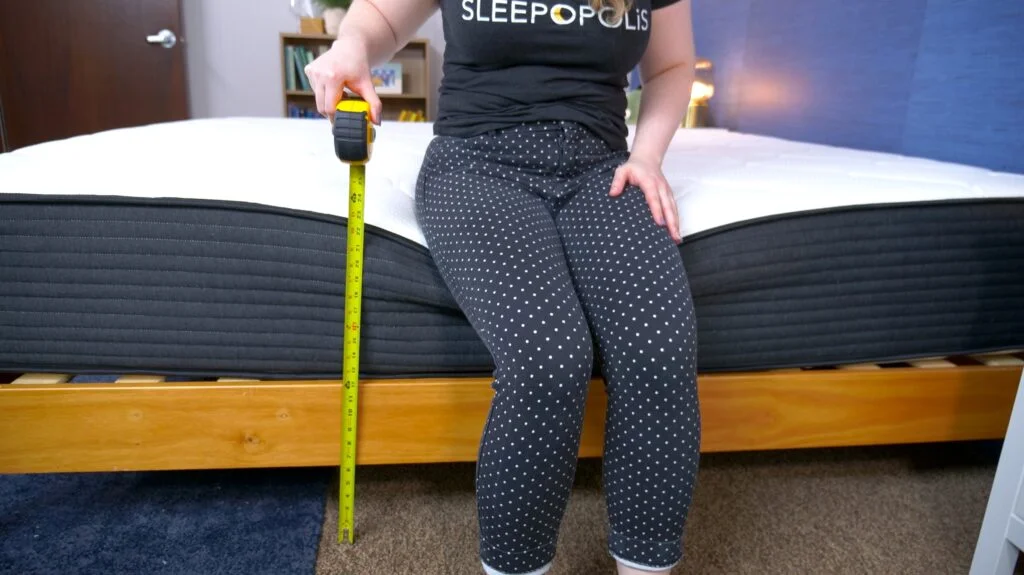
Buying a Mattress for Lightweight Sleepers
Average Cost
Most mattresses should cost around $1,500 for a queen size (that’s the market price before any discounts). Mattresses under $1,000 may run between $700 and $1,000, while luxury mattresses often cost around $2,000. Keep in mind that a super cheap mattress may not have quality materials that provide proper support and durability. At the same time, ridiculously expensive mattresses may not give you any more perks than a luxury mattress costing a few hundred dollars less.
Coupons and Deals
For exclusive discounts, check out our page for mattress coupons and promo codes.
Warranties and Sleep Trials
Warranties serve as a promise to customers that if a defective or damaged product is delivered, it will be replaced. Every company has different conditions, so it’s important to pay attention to the policy’s fine print.
Sleep trials are a set amount of time for the customer to test out the mattress. Make sure to use this sleep trial to its fullest potential, paying close attention to whether or not it suits your needs and preferences. Is the mattress truly best for your back pain? Is it cooling enough? Does it provide adequate comfort for both you and your spouse?
Sleep Tips for Lightweight Sleepers
- Create a Comfortable Environment: Invest in a good mattress and pillows, and keep the room cool and dark.
- Establish a Sleep Routine: Go to bed and wake up at the same time daily to regulate your internal clock.
- Limit Light Exposure: Reduce screen time and dim the lights an hour before bed to boost melatonin production.
- Practice Relaxation Techniques: Use deep breathing or meditation to unwind and prepare your mind for sleep.
FAQs
What is the best mattress for a light person?
While the best mattress for lightweight sleepers relies on your individual needs and preferences, the DreamCloud is our personal favorite. It should work well for lightweight sleepers in all sleeping positions, including combination sleepers. Most hot sleepers, those with back pain, and couples should be satisfied with its many features.
Do lighter people need softer mattresses?
Firmer mattresses are great for heavier sleepers or those who need more support, since they press through more of the mattress layers. Softer mattresses tend to be more comfortable for lightweight sleepers because they don’t sink too far into the surface. A softer option lets lightweight sleepers compress into the comfort layer and firmer layer to receive a necessary amount of comfort and support. That said, every sleeper is different; side sleepers need a softer mattress for pressure relief, while stomach sleepers require a firmer bed to keep the spine aligned.
What is considered a lightweight sleeper?
We consider those weighing under 130 pounds to be lightweight sleepers. Those between 150 pounds and 250 pounds are average weight sleepers, and folks above 250 pounds are categorized as heavier sleepers.
How We Chose These Mattresses
We’ve reviewed more than 220 products in our mattress lab, running each one through tests such as pressure-mapping and measuring motion transfer with a seismometer. From there, we give every bed an overall score based on materials, comfort, support, cooling, and edge support. We also factor in brand performance with categories such as value and warranty.
When determining the best mattresses for lightweight sleepers, we only picked products that have a trial period of 120 nights or longer. That way, lightweight sleepers will have plenty of time to determine if the mattress chosen best suits them. Click here to learn more about our methodology.
Recap: Best Mattresses for Lightweight Sleepers 2025
| Mattress | Best For | Price (Queen Size) | Coupon | Review |
|---|---|---|---|---|
| Helix Sunset | Overall | $1,373 | Helix Coupon | Read Review |
| DreamCloud | Joint Pain | $1,332 | DreamCloud Coupon | Read Review |
| Nectar Hybrid | Couples | $1,199 | Nectar Coupon | Read Review |
| WinkBed | Cooling | $1,799 | WinkBed Coupon | Read Review |
| Saatva | Stomach Sleepers | $1,770 | Saatva Coupon | Read Review |
| Nolah Evolution | Side Sleepers | $2,499 | Nolah Coupon | Read Review |
| Bear | Soft | $998 | Bear Coupon | Read Review |
| Brooklyn Bedding Signature Hybrid | Hybrid | $1,332 | Brooklyn Bedding Coupon | Read Review |
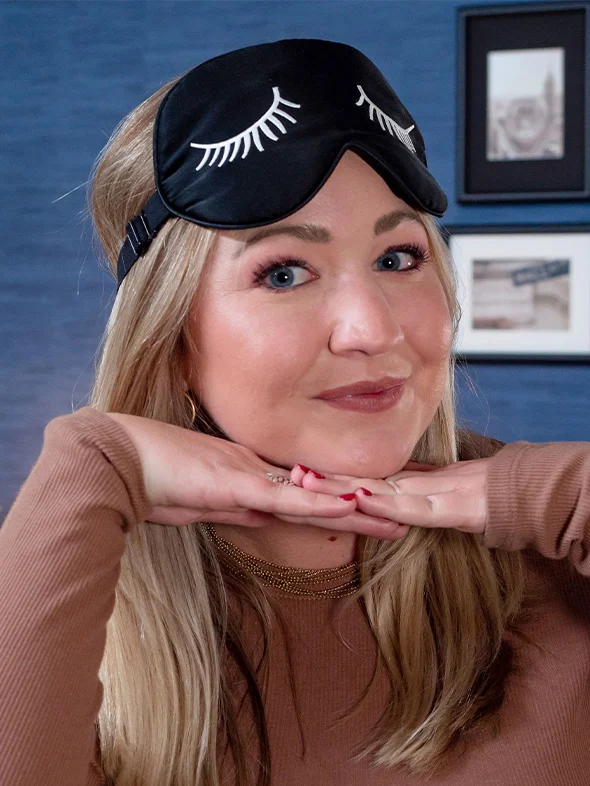
Bridget Chapman
Former Senior Product Editor
About Author
Bridget is a Certified Sleep Science Coach and senior editor here at Sleepopolis. From testing mattresses to writing about various sleep health topics, her goal is to help you get a good night’s sleep. You can also find her in videos on our YouTube channel. Bridget graduated magna cum laude from San Diego State University with a degree in journalism and a minor in English. Before joining the Sleepopolis team, she was a TV news reporter and worked in cities across the country. She loves spending time outdoors, checking out new restaurants, snuggling with her pets, and of course — getting some quality Zzz’s.
Combination Sleeper
